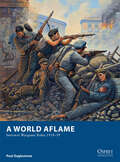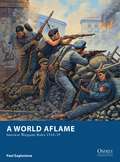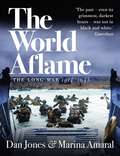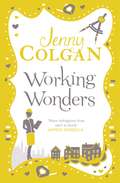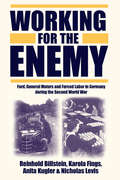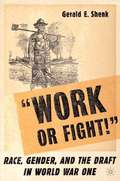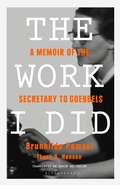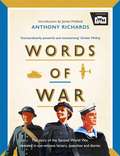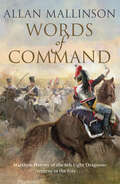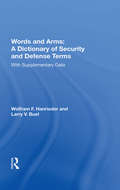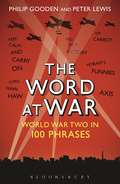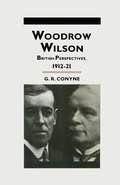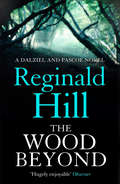- Table View
- List View
The World and All That It Holds
by Aleksandar Hemon'This life-stuffed novel is Aleksandar Hemon’s masterpiece' - David Mitchell, author of Cloud AtlasThe World and All That It Holds is the epic, cross-continental tale of a love so strong it conquers the Great War, revolution, and even death itself.As the Archduke Franz Ferdinand arrives in Sarajevo one June day in 1914, Rafael Pinto is busy crushing herbs and grinding tablets behind the counter at the pharmacy he inherited from his father. It’s not quite the life he had expected during his poetry-filled student days in libertine Vienna, but it’s nothing a dash of laudanum, a summer stroll and idle fantasies can’t put in perspective.And then the world explodes. In the trenches in Galicia, fantasies fall flat. Heroism gets a man killed quickly. War devours all that they have known, and the only thing Pinto has to live for are the attentions of Osman, a fellow soldier, a man of action to complement Pinto’s introspective, poetic soul; a charismatic storyteller and Pinto’s protector and lover.Together, Pinto and Osman will escape the trenches and find themselves entangled with spies and Bolsheviks. As they travel over mountains and across deserts, from one world to another, all the way to Shanghai, it is Pinto’s love for Osman that will truly survive.
A World Aflame: Interwar Wargame Rules 1918–39 (Osprey Wargames #2)
by Paul EaglestoneOften called the ”Pulp Era”, the years between the two World Wars have seen a tremendous surge in interest among wargamers. A World Aflame captures the adventurous nature of the time period to present a fun, fast-paced set of tabletop miniatures rules that can handle the many diverse conflicts of the period, from the Chinese Civil Wars and the “Great Game” in Central Asia, to the Irish War of Independence and the bitter ideological warfare of the Russian and Spanish Civil Wars. The rules also contain options for the “Very British Civil War”. This gaming trend has sprung up in recent years, following a “what-if” scenario that has Edward VIII refusing to abdicate the throne, thrusting the country into civil war in 1938. It is a quirky, fun setting, and one that is surprisingly popular. Written by a life-long wargamer, A World Aflame focuses on the daring and heroism of battles fought in the last great era of adventure.
A World Aflame: Interwar Wargame Rules 1918–39 (Osprey Wargames)
by Paul Eaglestone Mark StaceyOften called the †?Pulp Era†?, the years between the two World Wars have seen a tremendous surge in interest among wargamers. A World Aflame captures the adventurous nature of the time period to present a fun, fast-paced set of tabletop miniatures rules that can handle the many diverse conflicts of the period, from the Chinese Civil Wars and the "Great Game†? in Central Asia, to the Irish War of Independence and the bitter ideological warfare of the Russian and Spanish Civil Wars. The rules also contain options for the "Very British Civil War†?. This gaming trend has sprung up in recent years, following a "what-if†? scenario that has Edward VIII refusing to abdicate the throne, thrusting the country into civil war in 1938. It is a quirky, fun setting, and one that is surprisingly popular. Written by a life-long wargamer, A World Aflame focuses on the daring and heroism of battles fought in the last great era of adventure.
The World Aflame: The Long War, 1914-1945
by Dan Jones Marina Amaral'The events of the first and second world wars are brought to vivid, startling life thanks to Amaral's skill at colourising contemporary images' ObserverThe epic, harrowing and world-changing story – in words and colourized images – of global conflict from the assassination of the Archduke Franz Ferdinand to the obliteration of Hiroshima by the dropping of the first atom bomb. The World Aflame embraces not only the total conflagrations of 1914–18 and 1939–45 and the international tensions, conflicting ideologies and malign economic forces that set them in train, but also the civil wars of the interwar period in Ireland and Spain, wars in Latin America, Britain's imperial travails in such places as Ireland, Somalia and Palestine, and events on the domestic 'fronts' of the belligerent nations.Like The Colour of Time, this is a collaboration between the gifted Brazilian artist Marina Amaral, and the leading British historian Dan Jones. A fusion of amazing pictures and well-chosen and informative words, The World Aflame offers a moving – and often terrifying – perspective on the bloodiest century in human history.'A new perspective on the bloodiest half-century in history' Daily Mail'Immensely vivid' Sunday Times'Brings history to life in breaktaking technicolour' Financial Times'Revelatory' Daily Express'The past – even its grimmest, darkest hours – was not in black and white' Guardian
Working Wonders
by Jenny ColganLaughs, love, office life.And a little touch of magic … From the bestselling author of LOOKING FOR ANDREW MCCARTHY and AMANDA'S WEDDING.
Working for the Enemy: Ford, General Motors, and Forced Labor in Germany during the Second World War
by Reinhold Billstein Karola Fings Anita Kugler Nicholas LevisGeneral Motors, the largest corporation on earth today, has been the owner since 1929 of Adam Opel AG, Russelsheim, the maker of Opel cars. Ford Motor Company in 1931 built the Ford Werke factory in Cologne, now the headquarters of European Ford. In this book, historians tell the astonishing story of what happened at Opel and Ford Werke under the Third Reich, and of the aftermath today. Long before the Second World War, key American executives at Ford and General Motors were eager to do business with Nazi Germany. Ford Werke and Opel became indispensable suppliers to the German armed forces, together providing most of the trucks that later motorized the Nazi attempt to conquer Europe. After the outbreak of war in 1939, Opel converted its largest factory to warplane parts production, and both companies set up extensive maintenance and repair networks to help keep the war machine on wheels. During the war, the Nazi Reich used millions of POWs, civilians from German-occupied countries, and concentration camp prisoners as forced laborers in the German homefront economy. Starting in 1940, Ford Werke and Opel also made use of thousands of forced laborers. POWs and civilian detainees, deported to Germany by the Nazi authorities, were kept at private camps owned and managed by the companies. In the longest section of the book, ten people who were forced to work at Ford Werke recall their experiences in oral testimonies. For more than fifty years, legal and political obstacles frustrated efforts to gain compensation for Nazi-era forced labor; in the most recent case, a $12 billion lawsuit was filed against the computer giant I.B.M. by a group of Gypsy organizations. In 1998, former forced laborers filed dozens of class action lawsuits against German corporations in U.S. courts. The concluding chapter reviews the subsequent, immensely complex negotiations towards a settlement - which involved Germany, the United States, Poland, Russia, Ukraine, Belarus, Czech Republic, Israel and several other countries, as well as dozens of well-known German corporations.
Working for the Enemy: Ford, General Motors, and Forced Labor in Germany during the Second World War (Berghahn Ser.)
by Reinhold Billstein Karola Fings Anita Kugler Nicholas LevisGeneral Motors, the largest corporation on earth today, has been the owner since 1929 of Adam Opel AG, Russelsheim, the maker of Opel cars. Ford Motor Company in 1931 built the Ford Werke factory in Cologne, now the headquarters of European Ford. In this book, historians tell the astonishing story of what happened at Opel and Ford Werke under the Third Reich, and of the aftermath today. Long before the Second World War, key American executives at Ford and General Motors were eager to do business with Nazi Germany. Ford Werke and Opel became indispensable suppliers to the German armed forces, together providing most of the trucks that later motorized the Nazi attempt to conquer Europe. After the outbreak of war in 1939, Opel converted its largest factory to warplane parts production, and both companies set up extensive maintenance and repair networks to help keep the war machine on wheels. During the war, the Nazi Reich used millions of POWs, civilians from German-occupied countries, and concentration camp prisoners as forced laborers in the German homefront economy. Starting in 1940, Ford Werke and Opel also made use of thousands of forced laborers. POWs and civilian detainees, deported to Germany by the Nazi authorities, were kept at private camps owned and managed by the companies. In the longest section of the book, ten people who were forced to work at Ford Werke recall their experiences in oral testimonies. For more than fifty years, legal and political obstacles frustrated efforts to gain compensation for Nazi-era forced labor; in the most recent case, a $12 billion lawsuit was filed against the computer giant I.B.M. by a group of Gypsy organizations. In 1998, former forced laborers filed dozens of class action lawsuits against German corporations in U.S. courts. The concluding chapter reviews the subsequent, immensely complex negotiations towards a settlement - which involved Germany, the United States, Poland, Russia, Ukraine, Belarus, Czech Republic, Israel and several other countries, as well as dozens of well-known German corporations.
The Workhouse Sisters: The absolutely gripping and heartbreaking story of one woman’s journey to save her family (Workhouse to War)
by Kay BrellendAfter escaping the grip of the workhouse, Lily has kept her fiancé's business afloat while he is away fighting on the Western Front. Still battling on, she's now doing her bit for her country as an auxiliary nurse - but one thing above all else continues to weigh heavily on her heart: her long-lost sister.Born just before her mother died, the scandal was hushed-up and the baby spirited away. But now, at last, there is hope Lily could find her little sister for she has a clue to go on: the name of the notorious baby farmer who bought the child all those years ago. Mrs Jolley.Using all her pluck, and with the help of her two friends Margie and Fanny, Lily will do anything in her power to find her little sister and save her from the dark streets of London.With Winter drawing in, and the war with no end in sight, will she be able to bring her family together?
A Workhouse Christmas (Workhouse to War)
by Kay BrellendDiscover the Workhouse to War trilogy by Kay Brellend: a new saga series set in the Whitechapel Union workhouse in East London, between 1904 and 1916. Coming soon from Piatkus . . . Christmas Eve, 1909. When eleven-year-old Lily Larkin is left to fend for herself in an East London workhouse after her dying mother is taken to an infirmary, her future looks bleak. Once she is separated from her twin brother, Davy, her childhood hopes seem to shatter. But Lily's fierce spirit - along with her beloved new friends - help her to endure the miserable drudgery of life at South Grove Workhouse and its cruel supervisor, Miss Fox.When a handsome, smartly-dressed gentleman shows up at the workhouse, claiming to be her cousin and with an offer of employment, Lily seizes her chance to escape. But her new job is far from perfect, and her reunion with her brother isn't what she thought it would be. Still, she relishes her freedom from the workhouse, and, finding herself on the cusp of womanhood, is determined to embrace her new life - until a shocking secret from her past is uncovered. As everything she'd ever believed about herself is thrown into confusion, will Lily ever be able to rise above her past?Praise for Kay Brellend'Vividly rendered' Historical Novel Society'A fantastic cast of characters' Goodreads'Thoroughly absorbing' Goodreads
The Workers' War: British Industry and the First World War
by Anthony BurtonThe First World War: famous for the unprecedented loss of life on a global scale that affected the world forever. However, it wasn’t only in terms of bloodshed that the war rocked the nation, but also with its effect on the industrial integrity of Britain. This was a war not just of fighting, but of technological and industrial advances, in all areas from aviation and shipbuilding, to food production. Industries leapt ahead in terms of development over the four-year period: from the Wright Brothers in 1903 to the Sopwith Camel in 1917, and the first motorcars to the tank within twenty years. On a social level working Britain experienced change as well: with the men at war, it fell to the women of the country to keep the factories going. Here Burton explores one of the foremost paradigm shifts of the First World War.
“Work or Fight!”: Race, Gender, and the Draft in World War One
by G. ShenkDuring World War I the U.S. demanded that all able-bodied men work or fight. White men who were husbands and fathers, owned property or worked at approved jobs had the benefits of citizenship without fighting. Others were often barred from achieving these benefits. This book tells the stories of those affected by the Selective Service System.
The Work I Did: A Memoir of the Secretary to Goebbels
by Brunhilde Pomsel Thore D. HansenI know no one ever believes us nowadays – everyone thinks we knew everything. We knew nothing. It was all a well-kept secret. We believed it. We swallowed it. It seemed entirely plausible.'Whatever Pomsel's degree of guilt, her choice of words and actions raise important questions about coercion and complicity ... Reading this book we must hope that we can learn from history in a way that she could not' DAILY TELEGRAPH Brunhilde Pomsel described herself as an 'apolitical girl' and a 'figure on the margins'. How are we to reconcile this description with her chosen profession? Employed as a typist during the Second World War, she worked closely with one of the worst criminals in world history: Nazi Propaganda Minister Joseph Goebbels. She was one of the oldest surviving eyewitnesses to the internal workings of the Nazi power apparatus until her death in 2017. Her life, mirroring all the major breaks and continuities of the twentieth century, illustrates how far-right politics, authoritarian regimes and dictatorships can rise, and how political apathy can erode democracy. Compelling and unnerving, The Work I Did gives us intimate insight into political complexity at society's highest levels – at one of history's darkest moments.
Words of War: The story of the Second World War revealed in eye-witness letters, speeches and diaries
by Anthony Richards Imperial War Imperial War MuseumDuring the Second World War, across the frontline as well as on the Home Front, millions of people recorded their thoughts of their experiences - whether in letters, their personal diaries or those prosecuting the war giving speeches. Much as Letters of Note celebrated the great letters written through history, so Words of War allows the Imperial War Museum to showcase its incredible array of first-hand material to shine a light on how people journeyed through the 1939-45 conflict.Ten chapters take the reader chronologically through the key moments of the war: from the retreat to Dunkirk to the battle of the Atlantic; the savage fighting in the jungles of the far East to the RAF Bomber Command's campaign in Europe; the discovery of the Nazi's concentration camp system to the war's ultimate conclusion at the Nuremburg trials. One hundred documents are researched and selected by the Imperial War Museum's expert archivists, with commentary from their head Antony Richards explaining the significance of each and placing it in context to the war's progression. Readers will be able to engage and empathise with the writers in a thought-provoking and immediate way.
Words of Command: (Matthew Hervey 12) (Matthew Hervey #12)
by Allan MallinsonJanuary 1830, and one of the hardest winters in memory . . .And the prime minister, the Iron Duke, is resisting growing calls for parliamentary reform, provoking scenes of violent unrest in the countryside. But there are no police outside London and most of the yeomanry regiments, to whom the authorities had always turned when disorder threatened, have been disbanded as an economy measure. Against this inflammable backdrop Lieutenant-Colonel Matthew Hervey, recently returned from an assignment in the Balkans, takes command of his regiment, the 6th Light Dragoons. His fears that things might be a little dull are quickly dispelled by the everyday business of vexatious officers, difficult choices over which NCOs to promote not to mention the incendiarists on the doorstep of the King himself. But it’s when the Sixth are sent to Brussels for the fifteenth anniversary celebrations of the battle of Waterloo and find themselves caught up in the Belgian uprising against Dutch rule that the excitement really starts. Will Hervey be able to keep out of the fighting – a war that would lead, nearly a century later, to Britain’s involvement in an altogether different war – while safeguarding his country’s interests? Not likely!
Words And Arms: With Supplementary Data
by Wolfram F HanriederThis comprehensive dictionary of terms frequently used in discussions of national security and defense policy contains approximately 800 entries on weapons systems, strategy concepts, military organization, and related items. Part 2 presents a more extensive treatment of such concepts as strategic force doctrine and deployment, Soviet and U.S. poli
Words And Arms: With Supplementary Data
by Wolfram F HanriederThis comprehensive dictionary of terms frequently used in discussions of national security and defense policy contains approximately 800 entries on weapons systems, strategy concepts, military organization, and related items. Part 2 presents a more extensive treatment of such concepts as strategic force doctrine and deployment, Soviet and U.S. poli
The Word at War: World War Two in 100 Phrases
by Philip Gooden Peter LewisWar words have embedded themselves in our collective psyche; British politicians are fond of invoking the 'Dunkirk spirit' whenever the country is faced with major crisis or even minor adversity, and Roosevelt's famous description of Pearl Harbor as 'a date which will live in infamy' was echoed by many US commentators after the 9/11 attacks. So far, so familiar. Or is it? How many of us know, for instance, that 'Keep Calm and Carry On', far from achieving its morale-boosting aim, was considered at the time to be deeply patronizing by the people it was directed at, and so had only limited distribution? The Word at War explores 100 phrases spawned and popularized in the lead-up and during the conflict of World War Two. Substantial essays explore and explain the derivations of, and the stories behind, popular terms and phraseology of the period, including wartime speeches (and the words of Churchill, Hitler and FDR); service slang; national stereotypes; food and drink; and codewords.
The Word at War: World War Two in 100 Phrases
by Philip Gooden Peter LewisWar words have embedded themselves in our collective psyche; British politicians are fond of invoking the 'Dunkirk spirit' whenever the country is faced with major crisis or even minor adversity, and Roosevelt's famous description of Pearl Harbor as 'a date which will live in infamy' was echoed by many US commentators after the 9/11 attacks. So far, so familiar. Or is it? How many of us know, for instance, that 'Keep Calm and Carry On', far from achieving its morale-boosting aim, was considered at the time to be deeply patronizing by the people it was directed at, and so had only limited distribution? The Word at War explores 100 phrases spawned and popularized in the lead-up and during the conflict of World War Two. Substantial essays explore and explain the derivations of, and the stories behind, popular terms and phraseology of the period, including wartime speeches (and the words of Churchill, Hitler and FDR); service slang; national stereotypes; food and drink; and codewords.
The Woolworths Girl's Promise: Love, drama and tragedy converge as the Woolworths saga returns...
by Elaine EverestThe Woolworth Girl’s Promise is the heart warming eighth novel in Elaine Everest’s bestselling Woolworths series that follows the turbulent life of a much-loved Woolworths girl.After losing her beloved fiancé at Ypres in 1917, seventeen-year-old Elizabeth Billington faces a lonely future estranged from her upper-class parents due to her association with Charlie Sayers and his working-class family. No longer able to live under her parent’s roof she is taken in by Charlie’s father, escaping the suffocating demands of her parents.Betty soon learns all too well about the realities of life after an accident at the Woolwich Arsenal munitions works. Spotting an advertisement for a nearby job at Woolworths, Betty starts on a new and thrilling journey starting at the bottom of the employment ladder in the well-known store.Her work journey leads her to Ramsgate in Kent to work in a newly built store and with it the chance of marriage, but can she ever forget Charlie and the promise she made to him…?Read this exciting early chapter in the life of well-known Betty Billington and follow her journey before she arrives at the Erith store and meets fellow Woolworths Girls in 1938 as war is again on the horizon . . .
The Woolworths Girls (Woolworths #1)
by Elaine EverestCan romance blossom in times of trouble?It's 1938 and as the threat of war hangs over the country, Sarah Caselton is preparing for her new job at Woolworths. Before long, she forms a tight bond with two of her colleagues: the glamorous Maisie and shy Freda. The trio couldn't be more different, but they immediately form a close-knit friendship, sharing their hopes and dreams for the future. Sarah soon falls into the rhythm of her new position, enjoying the social events hosted by Woolies and her blossoming romance with young assistant manager, Alan. But with the threat of war clouding the horizon, the young men and women of Woolworths realize that there are bigger battles ahead. It's a dangerous time for the nation, and an even more perilous time to fall in love . . .Elaine Everest's The Woolworths Girls is followed by the festive sequel, Christmas at Woolworths.
Woodrow Wilson and the World War: A Chronicle Of Our Own Times (The World At War)
by Charles SeymourThis book was written right after the "Great War" it is a fantastic historical image of how contemporaries viewed the war, its causes, results, and how Woodrow Wilson managed and used it to further his ideological goal of Collective Security. It really is a great contemporary look of the situations surrounding the United States and World War I. It also has some previews of future prominent Americans such as Herbert Hoover and Franklin Roosevelt, before they were Presidents. (Excerpt from Goodreads)
Woodrow Wilson: British Perspectives, 1912–21 (Studies in Military and Strategic History)
by G.R. ConyneThis is a narrative study of British diplomatic perceptions of Woodrow Wilson during his presidential campaign and presidency. Using archival material not previously explored for this purpose, George Conyne is able to challenge the conventional view of British reactions to Wilson and American policy at the Paris Peace Conference. He casts fresh light on the sources and the consequences of their image of the president of the United States.
Woodrow Wilson: The First World War and Modern Internationalism (Seminar Studies)
by Michael R. CudeThis volume contributes to the Routledge Seminar Studies history series by providing a concise narrative overview of the ideas and foreign policy of Woodrow Wilson. It focuses on Wilson’s response to the First World War and his efforts to formulate a new international system, while also outlining Wilson’s policies toward different parts of the world. The book shows how Wilson shaped the direction of the 20th century in areas such as global governance, nationalism, decolonization, and international relations theory. In doing so, the book introduces the reader to the many debates over Wilsonian foreign policy. With a target audience of college undergraduates and non-experts, readers will gain a better understanding of Wilson’s vision for the world, his administration’s approaches to foreign policy, particularly during the First World War, and the global impact of his program.
Woodrow Wilson: The First World War and Modern Internationalism (Seminar Studies)
by Michael R. CudeThis volume contributes to the Routledge Seminar Studies history series by providing a concise narrative overview of the ideas and foreign policy of Woodrow Wilson. It focuses on Wilson’s response to the First World War and his efforts to formulate a new international system, while also outlining Wilson’s policies toward different parts of the world. The book shows how Wilson shaped the direction of the 20th century in areas such as global governance, nationalism, decolonization, and international relations theory. In doing so, the book introduces the reader to the many debates over Wilsonian foreign policy. With a target audience of college undergraduates and non-experts, readers will gain a better understanding of Wilson’s vision for the world, his administration’s approaches to foreign policy, particularly during the First World War, and the global impact of his program.
The Wood Beyond (Dalziel & Pascoe #14)
by Reginald Hill‘Hill’s wit is the constant, ironic foil to his vision, and to call this a mere crime novel is to say Everest is a nice little hill’ Frances Hegarty, Mail on Sunday

